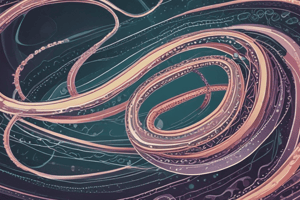Podcast
Questions and Answers
Who is known as the Father of Microbiology?
Who is known as the Father of Microbiology?
Anton Van Leeuwenhoek
What is microbiology concerned with?
What is microbiology concerned with?
- Study of human anatomy
- Study of parasites
- Chemical reactions in living beings
- Structure and classification of organisms (correct)
Match the following divisions of microbiology with their focus:
Match the following divisions of microbiology with their focus:
Bacteriology = Bacteria Mycology = Fungi Phycology = Algae Protozoology = Protozoan Virology = Virus
The Theory of Spontaneous Generation suggests that life can arise from nonliving matter.
The Theory of Spontaneous Generation suggests that life can arise from nonliving matter.
Who disproved the Theory of Spontaneous Generation?
Who disproved the Theory of Spontaneous Generation?
What is the study of fungi called?
What is the study of fungi called?
Which technique did Joseph Lister introduce to reduce microbes in medical settings?
Which technique did Joseph Lister introduce to reduce microbes in medical settings?
What is the field of study focused on viruses called?
What is the field of study focused on viruses called?
Flashcards are hidden until you start studying
Study Notes
Microbiology Definition and History
- Microbiology studies microorganisms, which include bacteria, archaea, algae, fungi, protozoa, and viruses.
- Anton Van Leeuwenhoek is recognized as the Father of Microbiology; he first observed live microorganisms using a simple microscope, achieving up to 300x magnification.
- He coined the term "animalcules" and documented his findings in letters to the Royal Society of London.
Divisions of Microbiology
- Bacteriology: The study of bacteria.
- Mycology: The study of fungi.
- Phycology: The study of algae.
- Protozoology: The study of protozoa.
- Virology: The study of viruses.
Early Theories of Origin of Life
- Spontaneous Generation: An early belief that life could arise from non-living matter through vital forces.
- Biogenesis: The theory that living things arise only from other living things, countering spontaneous generation.
Key Historical Figures
- Roger Bacon: Suggestive theorist on diseases being caused by invisible organisms.
- Francisco Redi: Opposed spontaneous generation through experiments on maggots and decaying meat.
- John Needham: Claimed microbes developed spontaneously from decaying fluids.
- Lazzaro Spallanzani: Believed microorganisms entered Needham's solutions post-boiling.
- Louis Pasteur: Disproved the theory of spontaneous generation and established the Germ Theory of Disease; developed pasteurization and fermentation techniques.
Modern Advances in Microbiology
- Joseph Lister: Introduced aseptic techniques in medical settings, preventing infections through disinfection and sterilization.
- Oliver Wendell Holmes: Observed higher infection rates in home births, prompting discussions on cleanliness.
- Ignaz Semmelweis: Linked maternal infections to physicians' lack of hygiene after performing autopsies.
Specializations within Microbiology
- Bacteriology: Focuses on the analysis and characterization of bacteria.
- Mycology: Studies various fungi, including their ecology and usage.
- Parasitology: Investigates protozoa and parasitic worms and their impact on hosts.
- Immunology: Explores the immune responses to pathogens.
- Virology: Covers the structure, classification, and effects of viruses on hosts.
Studying That Suits You
Use AI to generate personalized quizzes and flashcards to suit your learning preferences.




